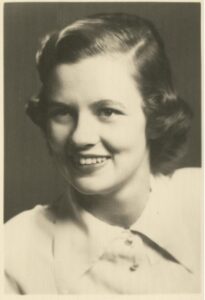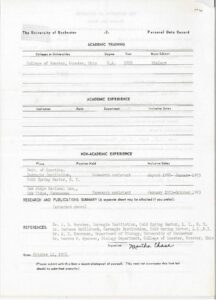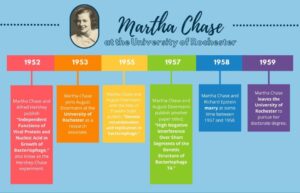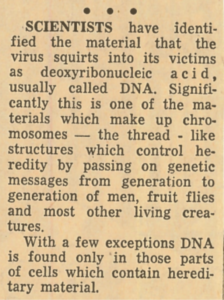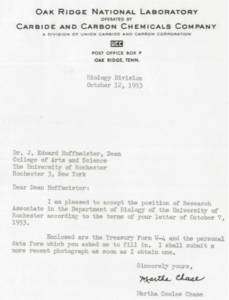Biology
Martha Chase at the University of Rochester: The Woman in STEM Who Was Forgotten
Spring 2024, Volume 22, Issue 2
Michelle A. Bischoff ‘24, Xuke Wang, Erin Song, Gabrielle Wilson, Monica Brody, Suchi Iyer, Kirya Caine, and Michael Clark*
https://doi.org/10.47761/HEMA1238
If you take a stroll through the fourth floor of Dewey Hall at the University of Rochester, you will pass a line of small offices. For students, these might house yet-to-be-graded papers, cramped office hours, and other mundane bits of everyday academia. However, if you pause in front of room 418, you stand near history. In 1953, this was not an office but the Doermann lab, and working inside was Martha Chase (Figure 1), one of the most notable names in this golden age of science: the infancy of molecular genetics. This article aims to delve into Martha Chase’s experience during her time at the University of Rochester, encompassing her scientific contributions, academic environment, and place within the university community. Despite making a significant contribution early in her career, Martha Chase’s personal and academic story is not a satisfying one to learn. She never secured a tenured position and was never given the chance to establish her own laboratory and research program. Because of a notable absence of scholarship regarding Martha Chase, we hope to rectify this gap with this work.
Figure 1. Photograph of Martha Chase included in the 1953 University of Rochester employee file.
Female ratio today vs. the 1950s
Over half of students in an introductory biology course are usually female (Sible et al., 2006). While this female-biased sex ratio is overlooked by students today, this was not the case when Martha Chase joined the University of Rochester in the 1950s. Using “The Interpres,” the student yearbook of the University of Rochester, we approximate the sex ratio of faculty and students in the STEM field from 1952-1959 to be only 7% female, making up 31% of graduating STEM students being female. (Interpres | Digital Collections, n.d.). Imagine only a handful of female students in a packed biology classroom or having every chemistry class taught by male professors—that was the reality of the University of Rochester in the 1950s. Striving in an environment like this, female scientists collaborated and supported each other. In Chase’s employment letter archived in the Department of Rare Books, Special Collections, and Preservation at Rush Rhees Library, we found a trace. Dr. Barbara McClintock, who studies the transposable element at Cornell University and won the Nobel Prize in 1983, is among the people of reference for Chase (The Nobel Prize in Physiology or Medicine 1983, 2018; Figure 2).
Figure 2. A set of references for Martha Chase. Chase’s references were from her former boss and coauthor Arthur Hershey, her boss at the University of Rochester August Doerman, her former undergraduate professor Warren Spencer, and future Nobel laureate Barbara McClintock.
Chase’s work before the University of Rochester
Chase has never been as well-known as the “Hershey-Chase Experiment”, unfortunately joining a long list of women in STEM who were denied the opportunities and accolades of their male counterparts. This article aims to remedy the latter, highlight her time at the University of Rochester, summarize her research, and begin to understand her place in the UR community.
In 1952, one year before joining the Biology Department at the University of Rochester, Martha Chase was working with Alfred Hershey at Cold Spring Harbor Laboratory. They collaborated on an experiment that would earn them a place in most introductory biology and genetics textbooks (Hershey & Chase, 1952). In this work, they tagged proteins and DNA of bacteriophages (viruses that infect bacteria) radioactively, tracking what was transferred into the bacteria during the initial stages of viral infection. They hypothesized that the material transferred would be the material of heredity. The results of this experiment provided important evidence for one of biology’s grandest conclusions: DNA is the material of heredity.
So how did a pivotal figure become effectively forgotten by the very institution she worked at, and what can we learn about her and the field of biology during the time of her contributions?
Martha Chase at the University of Rochester
In 1953, Martha Chase moved to the University of Rochester and worked in the lab of biology professor August Doermann (Figure 3). Chase’s work at the university revolved mostly around the budding field of molecular genetics with a focus on developing a greater understanding of the structure and function of phage and bacterial genetics, as well as how they could be used to understand eukaryotic organisms.
Figure 3. Timeline of Dr. Martha Chase’s time at the University of Rochester.
While the “Hershey-Chase Experiment” is famous, the rest of Chase’s scientific work from this period is far less known. Before moving to Rochester, Martha Chase worked in the Doermann lab along with graduate student Franklin Stahl at Oak Ridge National Laboratory. They focused on the genetic properties of bacteriophage, more specifically T2 and T4 (Hershey & Chase, 1952). The majority of new experiments in this research took place at Oak Ridge National Laboratory, with the remaining experiments and modeling done at the University of Rochester.
Many scientists were simultaneously exploring the nature of genetic material, and the scientific community had agreed on some key findings regarding the structure and function of DNA.The close relation between T2 and T4 in structure allowed scientists to transfer a similar component of the bacteriophage, the loci (gene), from one to another. What scientists discovered after the displacement of loci was the presence of similar counterparts in T2 and T4.
Together, Chase and Doermann ran groundbreaking research in the field of phage genetics, the study of how phages, or viruses, pass down their traits to their offspring. The discoveries scientists made in phage genetics helped them understand how genetics worked in humans. One experiment that Chase participated in during her time in the Doermann Lab included using ultraviolet radiation to cause mutations in phage DNA. The resulting lethal mutations were then combined to investigate the effects of recombination between different phage genomes (Doermann et al., 1955). They found that ultraviolet light could damage a single, a pair, or all of the three loci in assumed genetic materials. When these damaged phage genes were combined within a single bacterium, they could survive and reproduce, revealing how different phages exchange genes to survive. As the duration of the dose increases, so does the number of effective compensations from wild-genotype bacteria. Chase’s group stated that the ultraviolet irradiation targeted the genetic structure and genetic recombination with wild-type saved loci, protecting them from damage.
In addition, Martha Chase and August Doermann published a paper in phage genetics in 1958, titled “High Negative Interference Over Short Segments of the Genetic Structure of Bacteriophage T4” (Chase & Doermann, 1958). In this study, they aimed to establish map linearity in genes. A major conclusion of this work was that during gene mapping – the process of determining the locations of genes on chromosomes (condensed DNA) – genes are arranged in a specific order and displayed as a straight line. They also attempted to establish a relationship between the length of the gene and the length of the chromosome (Chase & Doermann, 1958).
After conducting their experiments and collecting their data, they discovered high negative interference over the genes in T4. This means that there is a higher rate of crossing over, or recombination, between two regions of chromosomes than normal. Recombination normally occurs when the chromosomes of two parents interact to create an offspring and gives the offspring a new and unique set of chromosomes and genes.
Although such findings are undoubtedly significant, Chase seems to have been overlooked when recognition was due. After the “Hershey-Chase Experiment,” Hershey would go on to win the 1969 Nobel Prize in Physiology and Medicine (The Nobel Prize in Physiology or Medicine 1969, 2019). However, Chase and her scientific career are less well-known, largely ignored even by scholars of the history of science. In Horace Judson’s exhaustive history of molecular biology, “The Eighth Day of Creation: The Makers of the Revolution in Biology,” Martha Chase was never individually mentioned–just referenced three times for her work with Hershey (Horace Freeland Judson, 1980). Even at the University of Rochester, where Martha Chase came to continue her work on the phage DNA following the “Hershey-Chase experiment,” there is no mention of her University affiliation outside a contemporary yearbook reference in 1958 (Interpres | Digital Collections, n.d.). Besides Chase, another notable member of the Doermann Lab was Franklin Stahl, best known for the famous “Meselson-Stahl Experiment,” where he and Matthew Meselson demonstrated that DNA is replicated by a semiconservative mechanism, meaning that each strand of DNA serves as a template for the production of a new strand (Meselson & Stahl, 1958). After receiving his bachelor’s degree at Harvard University, he matriculated to the University of Rochester to pursue his graduate studies (Franklin Stahl, 2022).
In 2015, Stahl published a memoir, “Serendipity and the Times,” where he reminisced about his time as a scientist (Stahl, 2015) and mentioned that he worked at the Doermann Lab. However, there is a notable absence of reference to Martha Chase, his coauthor and lab mate for several years.
Believing that Stahl might be our last connection to Chase and her life at the University of Rochester, we reached out to him through the alumni directory to gain more information, but he instead opted to not comment. This leaves us with no individuals left who remember Martha Chase and her legacy.
It appears that there is a testimony to Chase’s contribution in “The Interpres” of the year 1958, in which Chase is addressed as “Dr. Martha Chase,” although she did not receive her doctorate until 1964 (Dawson, 2003; Interpres | Digital Collections, n.d.). This inaccurate address, however, might indicate how Chase was perceived by others at the University of Rochester. While it may have been a simple mistake, it could also suggest a level of respect shown to her, at least by some members of the University of Rochester community.
Unfortunately, more evidence supports the idea that she was not given the respect or recognition that she deserved. A Rochester Times-Union article published in May 1956 describes some of the work that was conducted in the Doermann lab (Schmeck, 1956). One section of the article gives necessary background information about bacteriophage genetics in the “Hershey-Chase Experiment,” but simply describes the “scientists’” findings, failing to explicitly mention Martha Chase by name (Figure 4).
Figure 4. Excerpt from the article “Mystery of Infections by “Killed” Viruses” as published in the Times Union.
Martha Chase’s time at the University of Rochester, although brief, was meaningful and left a lasting impact on the field of genetics. It was two years before women had arrived at the University’s River Campus when Martha Chase inadvertently demonstrated to women that they had the opportunity to live out their passions in STEM. Historically, STEM majors were always thought of as a male-dominated field whereas women gravitated towards the humanities and smaller helping roles adjacent to sciences. Martha Chase was a great role model for women on campus, proving that they were capable of engaging in research and carrying out their ideas. This reigns true today. Chase was a pioneer for women on River Campus, challenging the traditional career paths women were encouraged to take and making her name known in the ever-evolving world of genetics. Today, River Campus sees women stepping into the roles of STEM professors, teaching assistants, lab instructors, and heads of departments. While it may not be directly attributed to the increase of women in STEM at the University of Rochester, Chase’s presence has facilitated greater opportunities for women to be involved in research and continue pushing boundaries for future generations.
Throughout history, women’s autonomy has been intricately linked to societal norms and expectations, often subjecting their ability to engage in seemingly mundane activities to approval from male figures or authoritative sources. While progress has been achieved in certain areas, research indicates that women’s access to higher education has been characterized by limitations that reveal the pervasive influence of gender norms. Over time, women were gradually allowed to attend universities, signifying a notable step toward empowerment. However, a closer examination reveals that their academic pursuits were often circumscribed by societal expectations, restricting their freedom to choose certain fields of study or pursue careers of their preference. Supporting evidence suggests that even within educational institutions, gender bias, and restrictions continue to persist, reflecting deeply ingrained stereotypes about women’s roles and their capabilities.
In 2020, the University of Rochester published multiple short stories highlighting women affiliated with the university with achievements in STEM. Despite featuring individuals with lesser ties to the university, there was no mention of Martha Chase or her accomplishments before joining the University of Rochester, during her tenure there, or even after her departure (Celebration 2020, n.d.; Celebration of Women 2020: Hajim School of Engineering and Applied Sciences: University of Rochester, n.d.; STEM archives, n.d.).
This is also reflected in the personal files of Martha Chase (Figure 2, 5-6). Something that is overlooked in the formal documents of female employees is their male-centered nature. In Chase’s personal data record, there is a section requiring her to provide her wife’s maiden name. While this practice helps trace lineage, the standardized question on a personal data record suggests that female employees at the University of Rochester were uncommon. In Chase’s paperwork, as she was unmarried at the beginning of her employment at the university, this section is simply crossed out.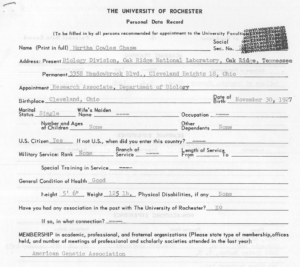 Figure 5. Excerpts from Martha Chase’s employment file at the University of Rochester.
Figure 5. Excerpts from Martha Chase’s employment file at the University of Rochester.
Figure 6. Martha Chase’s acceptance letter for the research associate position at the University of Rochester
Similarly, the endeavor for financial independence came with many challenges. Legalities and societal barriers impeded on women’s ability to open bank accounts independently and research indicates instances where married women in particular faced restrictions in managing their finances or accessing credit without a male co-signer (Haughn, 2023). In the mid-20th century, legal reforms began to address these inequalities. These limitations underscored a broader pattern of women’s economic dependency and highlighted the need for legal reforms to grant them equal financial agency. The ‘Married Women’s Property Acts’ enacted in the 19th century, gained momentum in the early 20th century and marked a significant shift by granting married women more control over their property and finances (Married Women’s Property Acts | United States [1839], n.d.). However, even after these legal changes, societal attitudes and practices persisted, perpetuating gendered expectations regarding financial roles within marriage.
The intersection of gender, societal expectations, and legal frameworks has shaped a narrative wherein women navigated a landscape by partial freedoms, underscoring the complex and ongoing struggle for gender equality across various facets of life. Within academia, particularly in STEM, societal norms have suggested that men were inherently more suited for these disciplines. However, with women breaking these barriers, their achievements can be attributed to a combination of societal, educational, and organizational changes.
Life after Rochester
After leaving the University of Rochester, Martha Chase attended the University of Southern California, where she received her doctoral degree in Microbiology in 1964. Following her PhD, Martha Chase’s career did not follow the typical route expected of a scientist with similar qualifications, experience, and connections to the research community. Unlike her male peers with comparable credentials, she was never offered a faculty position, never had her own laboratory, and never had the opportunity to pursue her own research questions. Martha Chase was the archetype of what it meant to be a woman in STEM during that era – a dedicated and hard-working individual who was deprived of sufficient recognition and opportunity. Ultimately, she ultimately moved back to Lorian, Ohio where she spent the remainder of her life with her family, away from the scientific institutions where she could have contributed more to the field. Furthermore, she spent the last decades of her life suffering from dementia which greatly affected her short-term memory. Martha Chase died from pneumonia at the age of seventy-five on August 8, 2003 (Lavietes, 2003).
So, who was Martha Chase? She was a prominent figure within the genetics community, whose contributions were largely forgotten with time due to the lack of opportunities, except for her most notable experiment with Alfred Hershey. The project to rediscover her story began with the publishing of her obituary, which revealed her affiliation with the University of Rochester’s biology department. At the time of her death, few, if any, at the University of Rochester knew that she had ever worked there. We hope this article will begin to revive interest in the life and work of Martha Chase and help inspire aspiring scientists from traditionally underrepresented groups. Her story serves as a reminder of what is lost when inequalities and unequal opportunities persist in the field of science.
References
Celebration 2020. (n.d.). Profiles – Celebration 2020 – University of Rochester. Celebration 2020. Retrieved February 14, 2024, from https://www.rochester.edu/2020-celebration/profiles/#science
Celebration of Women 2020 : Hajim School of Engineering and Applied Sciences : University of Rochester. (n.d.). Www.hajim.rochester.edu. Retrieved February 14, 2024, from https://www.hajim.rochester.edu/celebration-2020/2020-08-03-trends.html
Chase, M., & Doermann, A. H. (1958). HIGH NEGATIVE INTERFERENCE OVER SHORT SEGMENTS OF THE GENETIC STRUCTURE OF BACTERIOPHAGE T4. Genetics, 43(3), 332–353. https://doi.org/10.1093/genetics/43.3.332
Dawson, M. (2003). Martha Chase dies. Genome Biology, 4, spotlight-20030820-01. https://doi.org/10.1186/gb-spotlight-20030820-01
Doermann, A. H., Chase, M., & Stahl, F. W. (1955). Genetic recombination and replication in bacteriophage. Journal of Cellular and Comparative Physiology, 45(S2), 51–74. https://doi.org/10.1002/jcp.1030450505
Franklin Stahl. (2022, December 9). Wikipedia. https://en.wikipedia.org/wiki/Franklin_Stahl
Haughn, R. (2023, September 19). The History Of Women And Loans. Bankrate. https://www.bankrate.com/loans/personal-loans/history-of-women-and-loans/
Hershey, A. D., & CHASE, M. (1952). INDEPENDENT FUNCTIONS OF VIRAL PROTEIN AND NUCLEIC ACID IN GROWTH OF BACTERIOPHAGE. The Journal of General Physiology, 36(1), 39–56. https://doi.org/10.1085/jgp.36.1.39
Horace Freeland Judson. (1980). The Eighth Day of Creation. Simon & Schuster.
Interpres | Digital Collections. (n.d.). Digitalcollections.lib.rochester.edu. Retrieved February 9, 2024, from https://digitalcollections.lib.rochester.edu/ur/interpres
Lavietes, S. (2003, August 13). Martha Chase, 75, a Researcher Who Aided in DNA Experiment. The New York Times. https://www.nytimes.com/2003/08/13/us/martha-chase-75-a-researcher-who-aided-in-dna-experiment.html
Lehrman, G. (2014, July 16). The struggle for married women’s rights, circa 1880s | AP US History Study Guide from The Gilder Lehrman Institute of American History. Gilderlehrman.org. https://ap.gilderlehrman.org/resources/struggle-for-married-women%C3%A2%E2%82%AC%E2%84%A2s-rights-circa-1880s
Married Women’s Property Acts | United States [1839]. (n.d.). Encyclopedia Britannica. https://www.britannica.com/event/Married-Womens-Property-Acts-United-States-1839
Meselson, M., & Stahl, F. W. (1958). The replication of DNA in Escherichia coli. Proceedings of the National Academy of Sciences, 44(7), 671–682. https://doi.org/10.1073/pnas.44.7.671
Schmeck, H. (1956, May 22). Mystery of Infections by “Killed” Viruses. Times Union.
Sible, J. C., Wilhelm, D. E., & Lederman, M. (2006). Teaching Cell and Molecular Biology for Gender Equity. CBE—Life Sciences Education, 5(3), 227–238. https://doi.org/10.1187/cbe.05-08-0096
Stahl, F. (Frank) W. (2015). Serendipity and the times. Bacteriophage, 5(3), e1059003. https://doi.org/10.1080/21597081.2015.1059003
STEM Archives. (n.d.). The Rochester Effect. Retrieved February 14, 2024, from https://everbetter.rochester.edu/tag/stem/
The Nobel Prize in Physiology or Medicine 1969. (2019). NobelPrize.org. https://www.nobelprize.org/prizes/medicine/1969/hershey/biographical/
The Nobel Prize in Physiology or Medicine 1983. (2018). NobelPrize.org. https://www.nobelprize.org/prizes/medicine/1983/mcclintock/biographical/
About the Authors
Having met in BIOL 110 Principles of Biology I, we are a group of students who are surprised to learn that Martha Chase worked here at the University of Rochester, yet almost nothing is known for her time at the University. We established the Martha Chase Club to further our interest in advocating for underrepresented groups in science. Our academic interests include genetics, biochemistry, public health, and business. We aspire to be the role models of women in STEM in academia.
Cite this Article
Bischoff, M.A., Wang, X., Song, E., Wilson, G., Brody, M., Iyer, S., Caine, K., Clark, M. (2024). Martha Chase at the University of Rochester: The Woman in STEM Who Was Forgotten. University of Rochester, Journal of Undergraduate Research, 22(2). https://doi.org/10.47761/HEMA1238
JUR | Creative Commons Attribution 4.0 International License![]()

